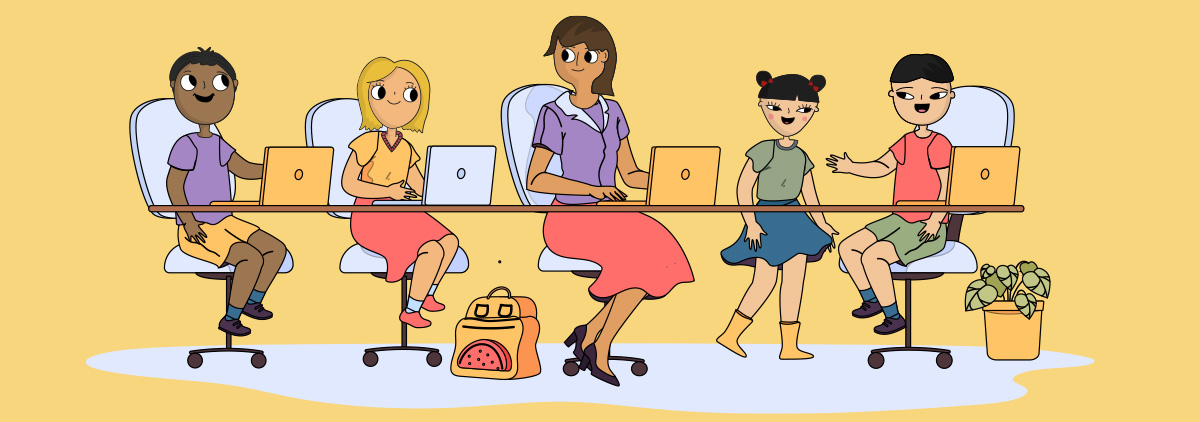As parents, we want to help our kids in whatever ways we can. But when it comes to computer science, that is often easier said than done. If you don’t have a background in coding and computing, it can be hard to know where to start.
One of the best ways for parents to support their child’s computer science is to get involved and take an active interest in what they’re doing. Ask your child about the projects they’re working on and encourage them to explain what they’re learning. Help them set goals and celebrate their successes, no matter how small they may seem.
You can also set them up with some amazing resources, such as coding tutorials, educational apps, and fun coding games. In this blog post, we’ll run through some of our favorites. Hopefully, after reading all this, you’ll feel a lot more confident when it comes to helping your kids.
Why should kids learn computer science?
Before trying to help your kids with computer science, it’s important to know why computer science skills are important. We wrote a full post about this not long ago, but let’s summarize some of the most important points.
On the simplest level: the modern world is run by technology, so it’s essential to become tech-literate. Some people say that computer science skills are as important as knowing how to read and write. And it’s never too soon to get started — in some places, children learn the basics of coding when they’re as young as 5 years old.
As well as this, computer science is great for a child’s personal development. Coding lets kids create their own computer programs, video games and websites, and this process inspires their imagination and boosts their self-esteem. Coding also encourages problem-solving skills and resilience in the face of problems.
Last but not least, when your kids grow up, they’ll have plenty of job opportunities to choose from. Computer programmers are in high demand, and by the time our children enter the workplace, this demand will be even higher. With computer science skills, the possibilities are endless, and your child’s future will be bright.
Unplugged activities
Now that we’ve established how important it is for our kids to learn principios de la informática, let’s look at some ways to help them out. We’ll start with a couple of unplugged activities. It might sound counterintuitive, but computer science doesn’t always need a computer. These unplugged activities are perfect for days when the sun is shining, and you want to work on computer science without staying cooped up inside.
Coding with chalk is a good place to start. All you need is a piece of chalk and a stretch of ground. Use the chalk to draw an 8×8 grid, with each square large enough to stand in. Next, it’s time to become a robot. Put down the chalk, enter the grid, and let your kid start calling instructions: turn left, turn right, step forwards.
Switch things around, and let your kid be the robot. Make it even more fun by setting some challenges, like getting to a certain spot or avoiding certain squares. Grab a water pistol, and spray anyone who makes a mistake. You’ll have a lot of fun with this one, and barely even notice that you’re learning skills, like algorithms, commands and sequencing.
You can do something similar with a deck of cards if you don’t have a suitable stretch of ground. Lay out the cards in an 8×8 grid, and place a little object, like your kid’s favorite toy, on one of the cards. Ask your kids to use instructions to guide the toy from card to card. Make things more interesting by turning some of the cards over, and creating a maze. Can your kid direct the toy from one side to the other without standing on a downturned card?
Other options
If you’re willing to splash a bit of cash, there are also some amazing board games out there. Here at CodeMonkey, we love Robot Turtles. The game is built around instruction cards (turn left, turn right, move forward), which players use to direct a turtle through a winding maze. And how about building a robot together? Again, this is pricier than coding with chalk, but it’s a great way to learn computer science in an exciting, hands-on way.
A great thing about all these unplugged activities is that you and your child can do them together. If you’re enthusiastic about computer science, your child will be enthusiastic too. It’s infectious — we get excited about things that other people care about, and activities like these are the perfect way to show your kids that you care.
Coding apps
Not all of us have time for unplugged activities. We’re too busy with work, or cleaning, or all those other annoying chores that eat up so much of our time. But that doesn’t mean you can’t still find ways to help your kids with computer science. Download some apps, and let your child play while you’re busy doing the hoovering. It’s amazing how many coding apps are available these days, and even more amazing that some of them are completely free.
Scratch is the most obvious option here. Back in 2007, they broke onto the scene with a revolutionary approach to children’s coding, and they’re still operating right at the cutting edge of the coding-for-kids arena. Scratch is designed for 8- to 16-year-olds, while ScratchJr, a simplified version, is available for 5- to 6-year-olds.
With Scratch, kids will use drag-and-drop blocks to create simple animations and games, learning about sequences, loops, and basic logic along the way. A lot of kids will already have played with Scratch at school, but setting it up on a home device is a really great way to help your child get better and better.
Other options
Blockly is another good example of an educational coding app. Their approach to coding is like a jigsaw puzzle, only the pieces are blocks of code. Kodable also comes with some free content, and for older kids, Monstruo de código is a fun way to pass the time. We should also mention CodeMonkey. Our approach is slightly different; we use narrative stories to teach coding to kids. If you download the app, your kid will write code to help a monkey gather as many bananas as possible, saving the world along the way.
There are so many brilliant options out there. Find them, download them, and see your kid go from strength to strength. Just don’t forget to ask them to show them what they’ve achieved today! However much cleaning you need to do, you can always find time to play the new game they’ve created on Scratch, and to tell them just how amazing it is.

Computer science classes
Another great way to support your kids with computer science is to sign them up for a class. Just like the apps we’ve already mentioned, there are loads of free options out there, many of which can be done from the safety of your home. We’re living in the age of remote learning, so why not take advantage?
Khan Academy is an amazing educational provider, not just in terms of computer science, but also in terms of history, grammar, math, geography, and plenty of other subjects. The computer science lessons use interactive videos called ‘talk-throughs,’ which allow students to pause at any time and experiment with code on-screen. Best of all, these lessons are completely free.
Challenge your kid to do one lesson per day. Maybe they can teach you about it afterward. There’s no better way to focus your learning than to explain it to someone else. And who knows? Maybe you’ll learn something yourself. If your kids are becoming computer science experts, why not become one too?
Other options
Codecademy is similar to Khan Academy. It offers a rich curriculum with free courses in coding, computer science, web development, and more. Codecademy is beginner friendly, but may not be suitable for kids under 13, as the lessons require a lot of reading. It’s entirely free, but does have a PRO option, which buys you access to live support from coding experts.
CodeWizardsHQ is another great option. They offer live, weekly coding lessons with professional instructors, and children can attend these online lessons in the same way they might attend an after-school club. The cost is a bit daunting, at several hundred dollars per course, but a lot of people would say that it’s worth it.
Classes like these can make a massive difference to your child’s understanding of computer science. As a parent, all you need to do is track down the best classes and sign your children up.
Introduce some role models
Last but not least, have you tried introducing your kids to some computer science role models? Children who love pop stars want to grow up to be singers; children who love sports stars want to grow up to be athletes; children who love coding stars want to grow up to be computer programmers.
Famous coders
Here are some famous coders to tell your kids about:
- Ada Lovelace. A mathematician and writer who is credited with writing the world’s first computer program.
- Tim Berners-Lee. The man who invented the World Wide Web.
- Hedy Lamarr. An actress and inventor, who is known for her contributions to the development of wireless communications.
- Linus Torvalds. A software engineer who created the Linux operating system, in the hope of making computer software more free and accessible.
- Grace Hopper. A pioneer in computer science and a rear admiral in the US Navy.
There are fictional role models out there too. The Agent Asha books tell the story of a child spy who uses coding and computer science to save the world. The Disney movie ‘Big Hero 6’ is about a tech-savvy teen who uses his coding skills as a force for good. There are plenty of examples out there, and more coming out all the time.
Role models are very important. If you want your kids to be inspired by computer science, they need to hear about inspirational people.
Final words
Hopefully you now feel confident helping your kids with computer science. Set up an activity, like a chalk-line grid, for you and your kids to play with. Download an educational coding app and encourage your kids to play. Sign them up for an online class and watch as they start to shine. Introduce them to some coding role models and ignite their imagination.
Whichever route you take, don’t be afraid to get involved and learn computer science alongside them. You can play the apps with them, or take the classes side by side, working as a team to solve the tasks. If you don’t have time for that, you should still make sure to ask your kids what they learned today. Get them to show off their projects, and make sure to dish out lots and lots of compliments.
Your child will feel more inspired if they know you care about the subject too. Enthusiasm is infectious, and it’s up to you to provide the spark. At the end of the day, there’s no better way to help a child: show them how much you care.





